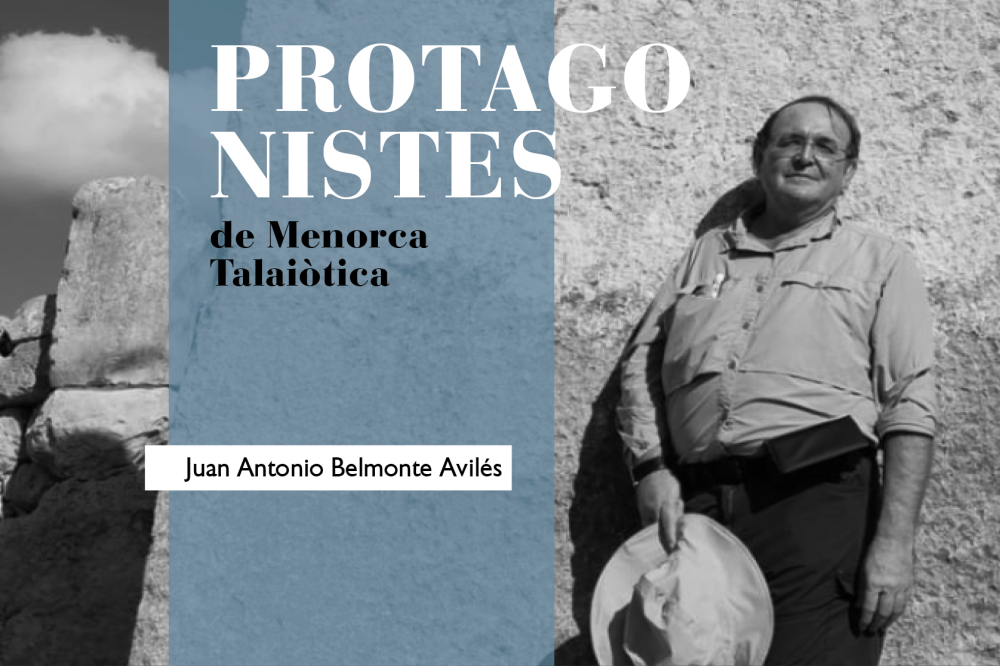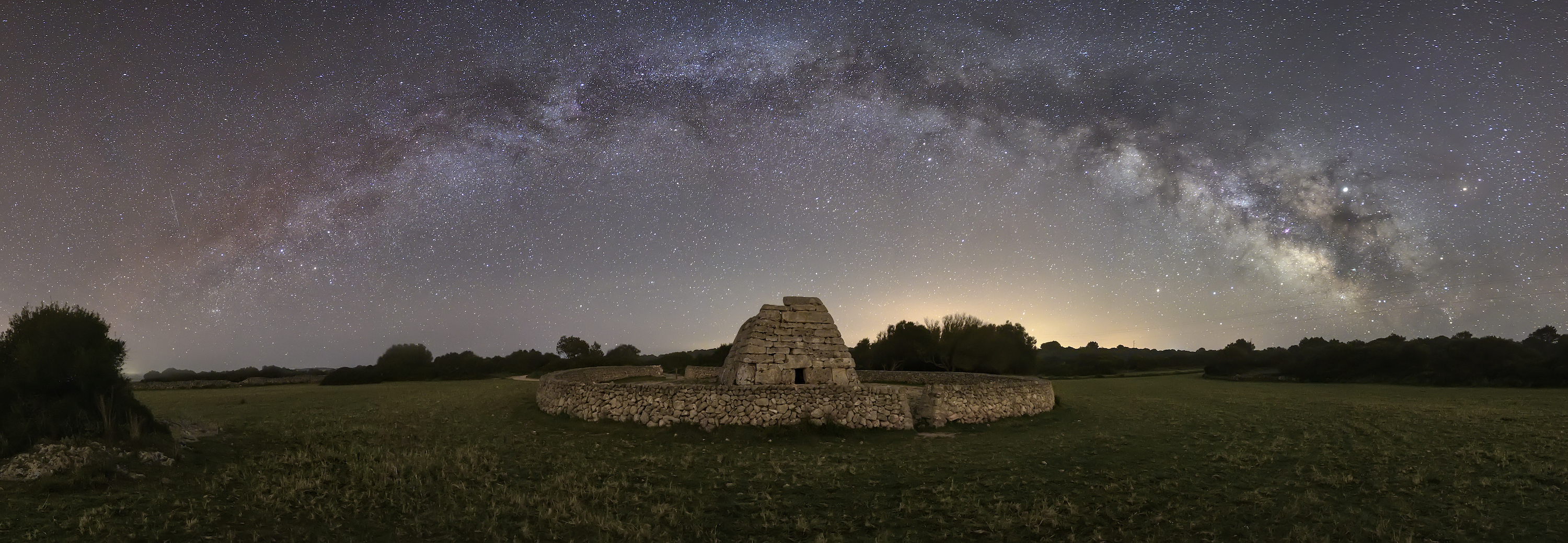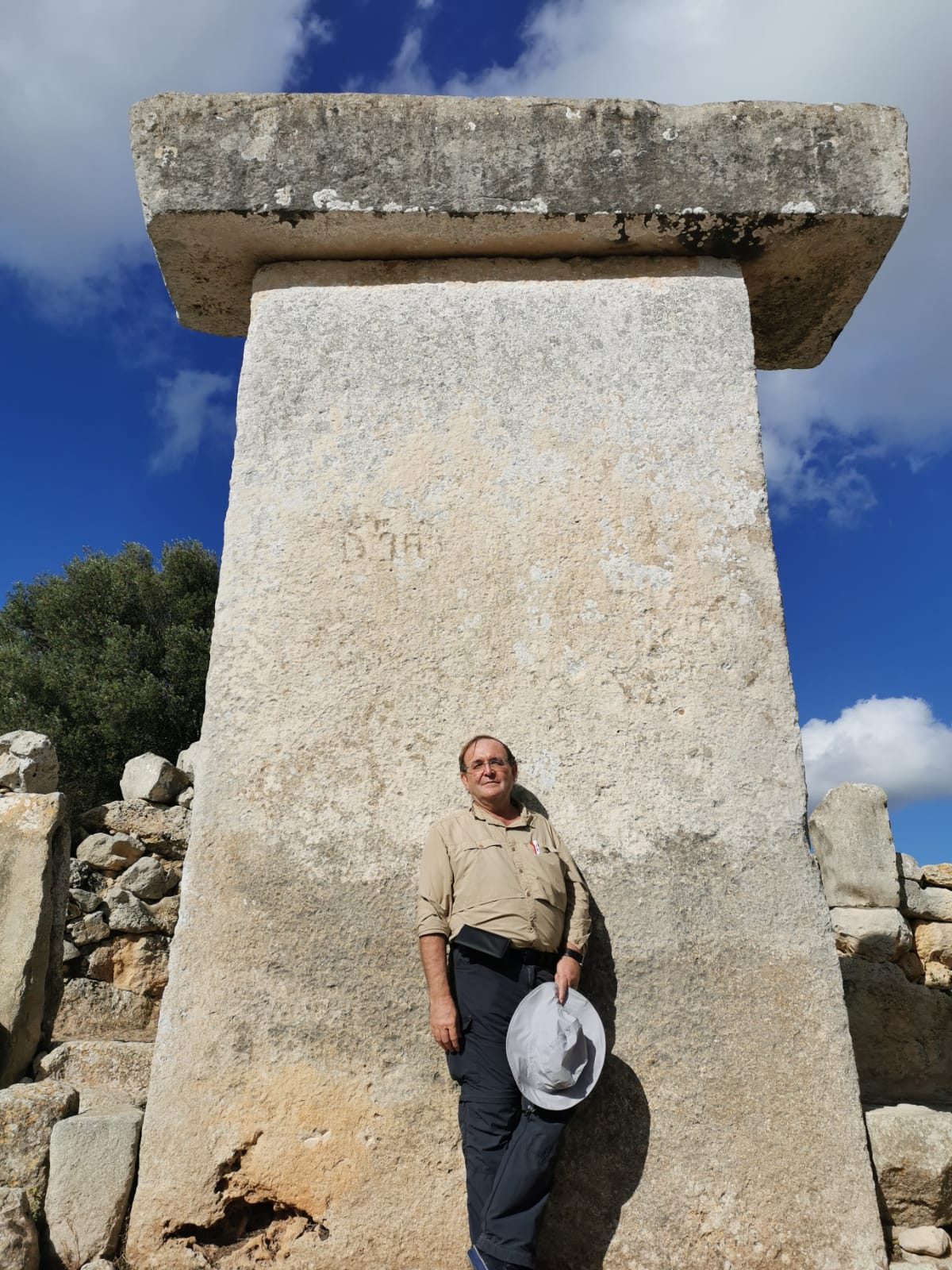 L’astrònom Juan Antonio Belmonte Avilés és membre del Consell Científic de l’Agència Menorca Talaiòtica i un dels autors de l’expedient de candidatura menorquina a patrimoni mundial de la UNESCO. Llicenciat en Ciències Físiques per la Universitat de Barcelona i Doctor en Astrofísica per la Universitat de La Laguna, desenvolupa la seva activitat professional com a Professor de Recerca a l’Institut d’Astrofísica de Canàries (IAC), des d’on porta a terme investigacions en exoplanetologia i arqueoastronomia. En les darreres dècades ha centrat les seves investigacions en les tradicions astronòmiques de les antigues cultures de la Mediterrània. Actualment, és president de la comissió “Patrimoni mundial i astronomia” de la Unió Astronòmica Internacional (IAU).
L’astrònom Juan Antonio Belmonte Avilés és membre del Consell Científic de l’Agència Menorca Talaiòtica i un dels autors de l’expedient de candidatura menorquina a patrimoni mundial de la UNESCO. Llicenciat en Ciències Físiques per la Universitat de Barcelona i Doctor en Astrofísica per la Universitat de La Laguna, desenvolupa la seva activitat professional com a Professor de Recerca a l’Institut d’Astrofísica de Canàries (IAC), des d’on porta a terme investigacions en exoplanetologia i arqueoastronomia. En les darreres dècades ha centrat les seves investigacions en les tradicions astronòmiques de les antigues cultures de la Mediterrània. Actualment, és president de la comissió “Patrimoni mundial i astronomia” de la Unió Astronòmica Internacional (IAU).
A aquesta tasca científica s’hi afegeix la seva àmplia trajectòria com a docent i divulgador: ha publicat una quinzena de llibres i ha redactat més de dos centenars d’articles sobre aquestes matèries, tant en revistes científiques com de divulgació. Està associat al Departament d’Astrofísica de la Universitat de La Laguna, on ha impartit classes d’Història de l’Astronomia i Arqueoastronomia, i hi imparteix Habitabilitat i Astrobiologia. També ha estat director del Museu de la Ciència i el Cosmos de Tenerife (1995-2000), president de la Societat Europea d’Astronomia Cultural (SEAC, 2005-2011) i del Comitè d’Adjudicació de Temps (CAT) dels observatoris de les Canàries (2003-2011).
Comencem coneixent una mica la vostra trajectòria personal. Què us va portar a inclinar-vos per l’estudi dels astres?
En els moments difícils de l’adolescència un pren decisions sense saber gairebé el perquè. La meva passió era la història i la geografia; la meva família estava plena de metges, semblava que el destí m’inclinava a aquesta darrera especialització. La història, a finals dels setanta, a més de la docència, no oferia més perspectives. I, de cop i volta, vaig descobrir l’astronomia. A més, per ser astrofísic calia estudiar Física, carrera que no existia a Múrcia, la meva ciutat natal.
Els meus germans no paraven de pressionar-me que havia de sortir de casa; per això sempre faig broma que si hi hagués hagut Física a Múrcia, jo seria arquitecte. I als 18 anys acabats de fer vaig prendre la decisió. Vaig marxar a Barcelona, però mai no vaig oblidar la meva passió per la història, les llengües antigues, l’arquitectura, la cosmografia. Egipte, Assíria i Roma serien una constant a la meva vida.
D’una passió va néixer una professió. Com us vau arribar a especialitzar en arqueoastronomia?
En acabar els meus estudis en l’especialitat d’Astrofísica a Barcelona, me’n vaig anar a l’IAC, a Tenerife, aleshores una institució jove però molt prometedora i il·lusionant. Vaig iniciar una tesi en física estel·lar i és molt possible que avui continués estudiant l’interior de les estrelles, a través de l’astrosismologia, si una sèrie de casualitats no m’haguessin posat davant d’una disciplina de la qual ho desconeixia tot però que m’oferia una perspectiva somiada d’unir totes les meves passions: l’arqueoastronomia.
No existia, i encara no existeix almenys en castellà, cap estudi reglat que permetés formar-se en una matèria transdisciplinària que s’escapava a totes les classificacions. Per això, es pot dir que soc autodidacte. Vaig llegir tot el que podia llegir, i vaig convidar a impartir part del curs del doctorat d’Història de l’Astronomia, del qual m’havia fet càrrec, la flor i nata de l’arqueoastronomia mundial. Anthony Aveni de Colgate, Michael Hoskin de Cambridge, Clive Ruggles de Leicester, Ivan Sprajç de Ljubliana, Stanislaw Iwanizewski de l’INAH, a Mèxic, Rolf Krauss de Berlín, entre d’altres, van passar per l’IAC i, al mateix temps que els meus alumnes, em vaig anar amarant dels seus coneixements i saber fer.
El canvi de segle va ser una època prodigiosa, en aquest sentit. El 2005, amb projectes en marxa a Egipte, la península Ibèrica, les illes de la Mediterrània, i el nord d’Àfrica, gairebé sense adonar-me’n, vaig ser elegit President de la SEAC. L’arqueoastronomia, ara més coneguda, i més ben citada, com a astronomia cultural, s’havia transformat d’una passió en una professió. El meu referent com a investigador des d’aleshores, juntament amb els exoplanetes, el meu cordó umbilical amb l’astrofísica.
 Quines dades proporciona l’arqueoastronomia per conèixer una cultura antiga com la talaiòtica?
Quines dades proporciona l’arqueoastronomia per conèixer una cultura antiga com la talaiòtica?
L’arqueoastronomia és una arqueometria més relacionada amb l’arqueologia del paisatge. No ens podem oblidar del que passa de l’horitzó cap amunt si volem entendre les societats del passat; el celatge era per a ells tan important com el seu entorn terrestre i marí, el paisatge. L’astronomia és, a més, l’única disciplina que ens permetia orientar-nos en el temps i l’espai, abans de la troballa de la brúixola, els GPS i els rellotges atòmics. A més, els cels, amb els seus moviments regulars i la seva aparent immutabilitat, oferien patrons que ajudaven a crear una cosmovisió i una escatologia que, encara que escapava a (gairebé) tota comprensió, produïa esperança.
Per això s’orientaven edificis cap a la volta celeste, i se’ls emmarcava dins del paisatge sense oblidar el celatge corresponent. S’hi establien patrons que se seguien durant segles. Es creaven calendaris mitjançant l’observació del sol, la lluna i els estels per controlar el temps. Es mapejaven els cels per tenir una guia, sobretot per navegar en mars procel·losos o en deserts inhòspits. Totes aquestes dades són les que analitza l’astronomia cultural i, en particular, l’arqueoastronomia quan parlem d’edificis antics. Menorca n’és un paradigma.
Què us va portar a l’estudi de la cultura talaiòtica i com va començar la vostra relació amb Menorca?
El responsable és el meu mentor, el professor Michael Hoskin, de la Universitat de Cambridge. En Michael havia estat pioner en els estudis d’arqueoastronomia a Espanya, precisament a Menorca, quan a finals dels vuitanta va treballar a les taules, les navetes i els sepulcres megalítics de l’illa. El 1993, ja fa trenta anys, vaig contactar amb ell per veure si volia contribuir a una obra col·lectiva, Arqueoastronomia Hispana, que editaria Equip Sirius, l’editorial de la revista [Tribuna de] Astronomía en aquell temps. La seva resposta va ser entusiasta.
A mi em va tocar traduir i editar els seus capítols, inclòs el dedicat a la cultura talaiòtica, i aquest va ser el meu primer contacte amb Menorca. A finals del segle XX vaig passar una llarga temporada a l’illa i me’n vaig enamorar. Poc després vaig treballar a Mallorca, i la cultura talaiòtica va passar a ser una més de les meves línies de treball, que a més vaig relacionar amb les meves feines a l’illa de Sardenya, tan diferent i alhora tan semblant a Menorca.
Com era la relació dels talaiòtics amb el celatge?
Els estudis d’arqueoastronomia demostren que la població que va arribar a les Balears fa poc més de 4.000 anys va importar amb ells els seus costums orientatius funeraris, cosa que ha servit per suggerir l’origen d’aquesta gent a les costes del Golf de Lleó.
D’altra banda, els cultes sumptuaris, representats pels recintes de taula, suggereixen la necessitat d’observar el cel en horitzons oberts, on s’entreveien patrons, asterismes (constel·lacions), avui invisibles des de l’illa de Menorca. La connexió directa entre aquests i els cultes se’ns escapa, però és molt suggerent adonar-se que quan aquestes estrelles van desaparèixer del cel menorquí, les taules es van deixar de construir. Tot i que la relació causa-efecte no és demostrable, no deixa de ser indicativa.
I quines eines o coneixements feien servir els talaiòtics per orientar-se amb les constel·lacions?
No sabem del cert quines constel·lacions coneixien els pobles de les Balears. Com que no navegaven, ignorem si van mapejar el cel amb aquest objectiu. Tampoc sabem si feien servir determinats asterismes per orientar-se en el temps, com per altra banda feien molts altres pobles mediterranis contemporanis. També desconeixem si rendien culte a alguna estrella, planeta o constel·lació.
Tot i això, sí que resulta suggerent adonar-se que Sirià, l’estrella més brillant del cel cap a la qual s’orienta la taula de Torralba, era una fita estacional de primer ordre, per exemple a Egipte, on a més era un avatar de la deessa Isis. La troballa de peces egípcies a les excavacions, o la menció de Caelestis a Son Catlar, és suggeridora però no podem anar gaire més enllà.
També s’ha parlat molt de la possible relació entre les cultures ciclòpies de Menorca i Sardenya; per això, el fet que edificis singulars d’aquestes dues civilitzacions estiguin orientats als mateixos grups d’estrelles, com la Creu del Sud o les lúcides de Centaure, planteja enigmes molt interessants.
Destacant la importància de la figura de Michael Hoskin, quines són les principals conclusions de les seves investigacions a Menorca en les quals vau col·laborar?
La meva col·laboració amb en Michael va culminar en la publicació el 2001 de Reflex del Cosmos, la nostra obra conjunta. Aleshores, jo ja havia assimilat totes les seves troballes a Balears i Ibèria fent-les meves, en cert sentit. Aquesta amistat i col·laboració va continuar durant les dues dècades següents fins que va morir el 2021 amb 91 anys.
Aleshores, jo era ja el principal divulgador del seu treball, barrejant-lo amb el meu. Les seves primeres hipòtesis es veien reforçades per les troballes posteriors; fins i tot van sobreviure a determinats canvis de paradigmes, com les noves dates per a les taules, més properes en el temps.
 Quina hipòtesi creieu més plausible per explicar les orientacions dels monuments talaiòtics?
Quina hipòtesi creieu més plausible per explicar les orientacions dels monuments talaiòtics?
Per tot l’anterior, quan va sorgir la possibilitat d’introduir els estudis d’astronomia cultural com un element més de la candidatura de Menorca Talaiòtica a patrimoni mundial, i donada l’avançada edat d’en Michael, jo em trobava en la posició ideal per fer d’ambaixador del cel de Menorca com un referent cultural de primer ordre, que caracteritzava els atributs i en reforçava el valor universal excepcional.
Vam plantejar quins podien ser aquells referents més importants que caracteritzaven l’illa i la singularitzaven a l’hora d’afrontar la tan necessària anàlisi comparativa amb els seus rivals potencials, com Sardenya o Malta, entre d’altres. Per això, vam reprendre les hipòtesis de l’orientació dels dòlmens, les navetes i les taules que havíem plantejat amb anterioritat.
Els monuments funeraris semblaven obeir un patró lunar. Les taules, un patró estel·lar. El sol, ara com ara, no ha ofert proves irrefutables, però els efectes de llums i ombres dins d’algunes coves funeràries ofereixen perspectives interessants per al futur.
Quin és el monument que creieu que representa millor la cosmovisió dels talaiòtics?
Pregunta difícil. El meu favorit és el recinte de taula de Torralba d’en Salort, però també és cert que és l’excepció a la regla, per la qual cosa no és l’estructura més representativa.
En aquest sentit, l’excepcional conjunt de Torre d’en Galmés és insuperable. Hi ha de tot: talaiots dominant el paisatge, una taula orientada al mar i a la Creu del Sud i, a prop, un dolmen (Ses Roques Llises), que evoca migracions del passat. Però podria seguir…
Com han contribuït els vostres estudis i els de Michael Hoskin a singularitzar la cultura talaiòtica de Menorca de cara a la possible nominació com a patrimoni mundial?
Després d’aquesta incertesa desesperant, si es completa amb èxit la declaració de patrimoni mundial a Riad d’aquí a uns mesos, que és el que tots esperem i desitgem, aquesta serà la tercera vegada que l’arqueoastronomia hagi tingut un paper rellevant en la inscripció d’un bé espanyol a la llista. Els antecedents han estat Antequera i els cims de Gran Canària. En tots m’hi he vist involucrat i la meva participació crec que ha representat algun dels moments de la meva carrera com a arqueoastrònom dels quals em sento més orgullós.
Sense en Michael, ni Antequera ni Menorca no haurien inclòs el celatge i la seva interacció amb el paisatge com una part fonamental del valor universal excepcional dels atributs de la candidatura. A Menorca, la seva situació, una terra tancada entre el cel i el mar, l’observació del celatge i la interacció amb el paisatge ha estat un element fonamental. Per això, era crucial que estiguessin representats a la memòria de la nominació i, per la meva experiència en el procés d’avaluació, en què va ser un plaer i un honor participar, i encara que no vull avançar esdeveniments, va ser un factor que va ajudar, i molt, a la posada en valor i al sex-appeal de la nostra candidatura.
En Michael va viure per veure els dòlmens d’Antequera declarats patrimoni mundial; estic segur que estarà molt orgullós, allà on sigui, encara que només sigui a la nostra memòria, quan Menorca Talaiòtica ho aconsegueixi.